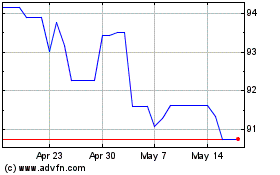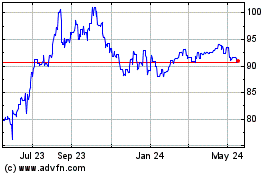Euro Sinks As ECB Chief Draghi Hints At Further Easing
January 21 2016 - 4:51AM
RTTF2
The euro re-entered the negative territory in European trading
on Thursday, after the European Central Bank chief Mario Draghi
hinted that the bank would "review and possibly reconsider" its
monetary policy stance at its next meeting in early March, as
downside risks to inflation had intensified amid global market
turmoil and plunging commodity prices.
In his customary press conference at Frankfurt, Draghi signaled
that euro area inflation dynamics continue to be weaker than
expected, as downside risks had risen further amid heightened
uncertainty about emerging market economies' growth prospects,
volatility in financial and commodity markets, and geopolitical
risks.
"It is therefore necessary to review and possibly reconsider our
monetary policy stance at our next meeting in early March, when the
new staff macroeconomic projections become available which will
also cover the year 2018," he told.
His comments came after the ECB left its interest rates
unchanged. The main refinancing rate was maintained at a record low
of 0.05 percent, the deposit rate was kept at a record low of -0.30
percent and the marginal lending rate was retained at 0.30
percent.
The euro showed mixed performance in the Asian session. While
the currency declined against the greenback and the pound, it held
steady against the franc and the yen.
The euro resumed its early decline against the greenback,
touching a 2-week low of 1.0778. This is down by 0.96 percent from
Wednesday's closing value of 1.0883. The euro-greenback pair is
likely to find support around the 1.06 region.
The single currency slipped to a 2-day low of 0.7640 against the
pound and more than a 9-month low of 126.16 against the yen,
reversing from its prior highs of 0.7742 and 127.87, respectively.
Continuation of the euro's downtrend may lead it to support levels
of around 0.75 against the pound and 124.00 against the yen.
Pulling away from an early high of 1.0973 against the Swiss
franc, the euro edged down to 1.0918. Further weakness may take the
euro to a support around the 1.08 mark.
Figures from the Swiss National Bank showed that Switzerland's
money supply growth slowed in December, after improving in the
previous two months.
M3, the broad measure of money supply, rose at a slower pace of
1.6 percent year-over-year in December, following a 2.1 percent
spike in November. In October, the rate of increase was 1.4
percent.
The euro weakened to a 2-day low of 1.6722 against the kiwi,
6-day low of 1.5554 against the aussie and an 8-day low of 1.5522
against the loonie, after having advanced to 1.7010, 1.5881 and
1.5876, respectively in early deals. The euro is seen finding
support around 1.65 against the kiwi, 1.54 against the aussie and
1.53 against the loonie.
Looking ahead, weekly U.S. crude oil inventories data and
Eurozone consumer confidence index for January are due to be
released shortly.
US Dollar vs RUB (FX:USDRUB)
Forex Chart
From Oct 2024 to Nov 2024

US Dollar vs RUB (FX:USDRUB)
Forex Chart
From Nov 2023 to Nov 2024
